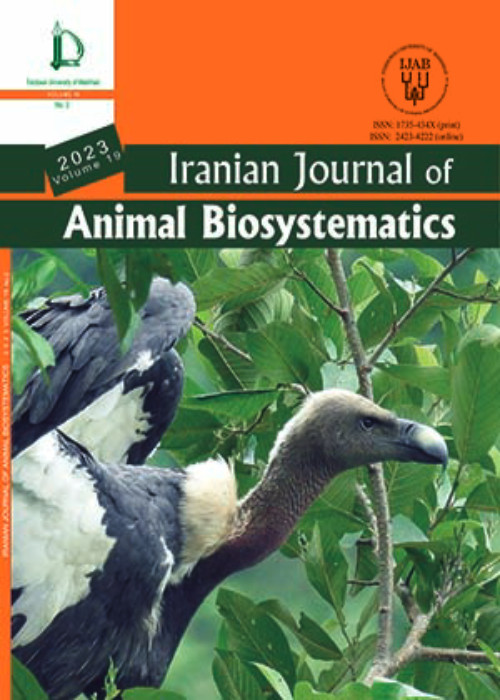فهرست مطالب
Iranian journal of animal biosystematics
Volume:10 Issue: 1, Winter-Spring 2014
- تاریخ انتشار: 1393/06/28
- تعداد عناوین: 10
-
-
Page 1In this paper we present Thysanus Walker, a genus new to the Iranian fauna. Only one species has been identified in Iran: Thysanus ater Walker, 1840. We illustrate the species morphology of wings, antennae, head, thorax and abdomen.Keywords: Thysanus ater, Signiphoridae, new genus, species record, Iran
-
Page 5During field work in western regions of the Iranian Plateau in the Zagros Mountains in September 2010, a single specimen belonging to the genus and subgenus Eremias Fitzinger, 1834 was collected from the protected area of Bijar (at about 1619 m elevation) in north of the city of Bijar, Kurdistan Province, western Iran (47°, 34’ E; 36°, 00’ N).Keywords: Lacertidae, Eremias (Eremias) strauchi strauchi, new record, Bijar, Kurdistan Province, western Iran
-
Page 11This study describes the influences of variations in life history traits and developmental patterns of Pelophylax ridibunda. The causes of this variation were investigated by comparing observed patterns of interpopulational differences from geographic variables. The aim of the study was to investigate whether embryos and larvae from different populations of P. ridibunda show the same pattern of development when they are reared in the same conditions in the laboratory and to find out further whether if any differences appearing in the pattern among populations is environmentaly or geneticaly based. Egg masses of P. ridibunda were collected from four sites in Fars Province, Iran and reared in the same conditions. Samples from most of the developmental stages were fixed and clutch parameters were measured at early developmental stages. Morphological characters in embryos and larvae including egg diameter, growing size of embryos and larvae at different stages, external gill, cement gland and mouth parts structures were examined with light and scanning electron microscopy. Statistical analysis showed that the mean diameter of eggs and jelly coats were significantly different (p)Keywords: Pelophylax ridibunda, Fars Province, Iran, developmental patterns, local adaptation, intraspecific variation
-
Page 29In the present study, we reported the results of the monitoring and investigations of the ichthyofauna of the Beshar River, one of the tributaries of the Tigris−Euphrates basin in Kohkiluyeh and Boyer-Ahmad Province, southwest of Iran. The results showed that during a period from 2010 to 2011, a total of 13 fish species belonging to 4 families and 3 orders were recorded in the Beshar River. The results indicated that among families of ichthyofauna identified the largest family was Cyprinidae with 9 species and 69.23 percent abundance and the dominated species was the Garra rufa with 30.28 percent abundance. The Beshar River ichthyofauna is a combination of fauna and includes 6.5, 14.3 and 17.7 % of species, family and order of Iran freshwater fish fauna respectively.Keywords: Ichthyofauna, Beshar River, Cyprinidae, Garra rufa, Iran
-
Page 36Predatory birds feed mainly on small mammals. They usually swallow their prey and after digesting, the indigestible fur, bones and teeth are regurgitated as compact pellets. The investigation of pellet is an extremely valuable tool for mammalogists. In this study 351 pellets have been collected from the localities including north of khorasan, Zanjan, Yazd, Chahar Mahal va Bakhtiyari and Mazandaran Provinces, Iran. Results have revealed the most of pellets contain mainly the members of five families of rodents including Muridae, Dipodidae, Cricetidae, Sciuridae and Calomysidae, respectively. Although it is evident that dental morphology is a valuable tool to recognition the most genera, it is not enough for the specific identification in some cases such as Meriones and Microtus. Therefore, it would be essential employing additional approaches such as neontology and morphometrics geometric.Keywords: Pellet, Rodent, Identification, Iran, Muridae
-
Page 51We studied 1038 bp of cytochrome b gene for social voles from three localities in Iran. The new sequences were compared with the previous published data correspond to eight species of social voles. Our results indicated that new material from west of Iran belong to the two species; M. socialis and M. irani karamani. This finding led to prove more knowledge about the Iranian vole distribution rang in Iran, and showed that west part of Iran is occupied with three social voles; M. socialis, M. qazvinensis that already have been documented, and M. irani karamani that is a new addition record for Iran.
-
Page 57A faunistic review is given on the Iranian medically important spiders of two genera Loxosceles and Latrodectus. Latrodectus cinctus Blackwall, 1865 is reported for the first time from Iran (and for the second time from Asia) and is replaced with the previous erroneous reports of L. hasseltii Thorell, 1870. The following species are reported for the first time from the listed provinces: Loxosceles rufescens (Dufour, 1820) (Fars and Hormozgan), L. dahli Levi, 1959 (Hormozgan), L. pallidus O.P.-Cambridge, 1872 (Alborz and Semnan) and L. tredecimguttatus (Rossi, 1790) (Alborz, Qom, Semnan and Tehran).Keywords: cytotoxicity, envenomation, faunistic, neurotoxicity, recluse spider, widow spider
-
Page 67There are two species of Ghost shrimps namely, Neocallichirus jousseaumei, N. calmani of which the latter is the first record for the Persian Gulf (littoral and subtidal zones). While, N. jousseaumei is first record for littoral zones along coastal waters of the Persian Gulf. The material of present study was collected from Ouli village along the coast of Bushehr Province. Here, Notes on habitat preferences, symbiotic animals and some morphological characters used for identification of two species is presented.Keywords: Persian Gulf, Neocallichirus Jousseaumei, N. calmani, habitat preferences, symbiotic animals
-
Page 73Hadula vassilinini (O. Bang Haas, 1927) was collected in crop fields'' areas of Khuzestan province, south-west Iran. Adults and genitalia are illustrated, with notes on bionomy and distribution. This is the first record of this species from Iran with description of the previously undescribed female.Keywords: Noctuidae, faunistics, Hadula vassilinini, Iran


